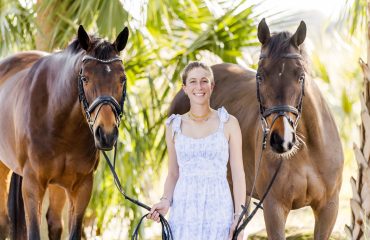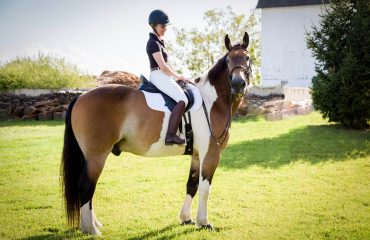 A sought-after trainer and clinician, American Olympic dressage rider Christine Traurig was born and raised on her parents’ breeding farm near Verden, Germany. She rode and trained for the Hanoverian Elite Sales in Verden before moving to the United States in 1982, where she assisted Bernie Traurig in operating an import and sales business of dressage horses and jumpers. Christine and Bernie were instrumental in establishing the Saudi Arabian Equestrian Team and Federation. With her equine partner Etienne, Christine was a member of the 2000 Sydney Olympic bronze medal team. She now operates Christine Traurig Dressage Stables, Inc. in Rancho Santa Fe, California. She conducts clinics and symposiums all over the U.S. and in 2015, was appointed to the position of USEF National Coach for Young Dressage Horses. Do you have a question you want Christine to answer? Send questions to editor@sidelinesnews.com.
A sought-after trainer and clinician, American Olympic dressage rider Christine Traurig was born and raised on her parents’ breeding farm near Verden, Germany. She rode and trained for the Hanoverian Elite Sales in Verden before moving to the United States in 1982, where she assisted Bernie Traurig in operating an import and sales business of dressage horses and jumpers. Christine and Bernie were instrumental in establishing the Saudi Arabian Equestrian Team and Federation. With her equine partner Etienne, Christine was a member of the 2000 Sydney Olympic bronze medal team. She now operates Christine Traurig Dressage Stables, Inc. in Rancho Santa Fe, California. She conducts clinics and symposiums all over the U.S. and in 2015, was appointed to the position of USEF National Coach for Young Dressage Horses. Do you have a question you want Christine to answer? Send questions to editor@sidelinesnews.com.
What do you suggest as a warm-up for a horse?
There are many factors to consider when planning a warm-up for the horse: the age of the horse, the fitness of the horse, the stage of training in relation to the level, and last but not least, the temperament of the horse. There is no set formula. The rider and the trainer have to figure out what works best for the horse. Some horses like a long, slow warm-up for about 45 minutes to an hour. For others, a schooling session several hours before the competition followed by a short warm-up of 15 to 20 minutes could be perfect. To sum it up: The horse has to be relaxed, supple and on the aids to perform the exercises asked for in the test. One thing my mentor always told me: If you have to start training for the exercises in the warm-up, you don’t belong in the competition. The training is done at home.
What are some of the main things you do as the U.S. Young Horse Coach?
One of the main things I do as the young horse coach is the USEF training sessions throughout the country in order to find, coach and guide talented young horse-and-rider combinations in the effort to have more and more horses emerge through the program and continue on to develop into top international horses, to hopefully represent the U.S. in international competition in the future. I’m present as an observer and coach at the Markel/USEF Young and Developing Horse Dressage Championships each year. I also accompany horse/rider combinations selected to represent the U.S. at the World Breeding Dressage Championships for Young Horses in Ermelo as their coach.
It’s a passionate goal of mine to encourage our breeders to breed the best horses and to make sure these horses get the right exposure being ridden by capable riders with experience in training young horses. We have to produce more quality in bigger numbers to have a pool of horses to draw from to make up future teams. However, we can’t limit ourselves to just the horses that are bred in the U.S. The leading countries are moving fast. We have to stay current according to the trends in breeding and performance and stay in the game.
What qualifications should a rider have before hoping to work with a younger horse?
A balanced and secure seat are definitely important. Riding without fear is important. I believe young people should ride young horses, most certainly during the ages of 3 and 4 years old, because they are more flexible in their body and quicker in their reactions toward the at-times “rambunctious or free-spirited” behavior of a young horse. Some of the best riders for these young horses are riders who came up through the grass roots, who didn’t have the privilege to learn from schoolmasters but rode “what they had.” Most important is that whoever rides and trains a young horse does it under the supervision of a trainer/rider who has had a lot of experience with it.
How long should practice sessions be on my horse? I know I want to end on a good note, but how long is too long or too short to be beneficial?
I don’t think a practice session should be longer than one hour and that’s including the warm-up and walk breaks during the session as well as the cooling out of the horse. Not every day brings advancement or achievement of the desired goal. This is normal. Horses have bad days or just don’t feel up to it at times. It’s important to finish on a good note, which means sometimes it’s necessary to take a step back and finish with an exercise that is easier than the targeted goal so that the horse finishes feeling confident and relaxed. The motto is: Quit while you are ahead! Finish your session with simple transitions, which keep your horse relaxed and on fundamental aids and prepared for the next day.
Is keeping “heels down” as important in dressage as it is in jumping disciplines?
“Heels down” is part of a correct position demonstrating a stable, supple and balanced seat independent from the hands of the rider. In jumpers, heels down in the two-point or forward seat means that the rider can maintain position without gripping onto the horse with their lower leg, meaning that the rider is balanced in the stirrups and the rider’s body weight is in the stirrups while in a light forward seat. In dressage the rider most certainly has weight on his seat bones while sitting — however, some of that weight is transmitted though the upper and lower leg down and around the horse into the heels, which defines the phrase “heels down.” “Heels down” is important; it’s an essential part of correct equestrian form. The correct function of aids depends on correct form.













